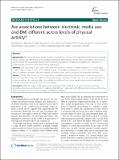Files in this item
Are associations between electronic media use and BMI different across levels of physical activity?
Item metadata
| dc.contributor.author | Melkevik, Ole | |
| dc.contributor.author | Haug, Ellen | |
| dc.contributor.author | Rasmussen, Mette | |
| dc.contributor.author | Fismen, AS | |
| dc.contributor.author | Wold, Bente | |
| dc.contributor.author | Borracino, Alberto | |
| dc.contributor.author | Sigmund, E | |
| dc.contributor.author | Balazsi, R | |
| dc.contributor.author | Bucksch, Jens | |
| dc.contributor.author | Inchley, Jo | |
| dc.contributor.author | Gaspar de Matos, Margarida | |
| dc.contributor.author | Samdal, Oddrun | |
| dc.date.accessioned | 2015-06-12T15:40:02Z | |
| dc.date.available | 2015-06-12T15:40:02Z | |
| dc.date.issued | 2015-05-19 | |
| dc.identifier | 192600585 | |
| dc.identifier | b4592d7e-2102-4ece-b6cd-0c5551ecb35e | |
| dc.identifier | 84930003086 | |
| dc.identifier | 000354917600001 | |
| dc.identifier.citation | Melkevik , O , Haug , E , Rasmussen , M , Fismen , AS , Wold , B , Borracino , A , Sigmund , E , Balazsi , R , Bucksch , J , Inchley , J , Gaspar de Matos , M & Samdal , O 2015 , ' Are associations between electronic media use and BMI different across levels of physical activity? ' , BMC Public Health , vol. 15 . https://doi.org/10.1186/s12889-015-1810-6 | en |
| dc.identifier.issn | 1471-2458 | |
| dc.identifier.other | ORCID: /0000-0001-8322-8817/work/65014203 | |
| dc.identifier.uri | https://hdl.handle.net/10023/6820 | |
| dc.description.abstract | Background The use of electronic media has been found to be a risk factor for higher BMI and for being overweight. Physical activity has been found to be associated with lower BMI and lower risk for being overweight. Little is known about whether the associations between physical activity and electronic media use are additive or interactive in predicting BMI and risk for overweight among adolescents. Methods The data used in this study stem from the 2009/2010 survey of “Health Behaviour in School-aged Children (HBSC) study: A WHO Cross-National Survey. The sample consisted of 107184 13 and 15 year students from 30 different countries. Multilevel regression models were used to produce the presented estimates. Results Overall, 18% of boys and 11% of girls were classified as overweight. EM use was found to be associated with increased BMI z-scores and odds for overweight among both boys and girls who did not comply with physical activity guidelines. Among physically active adolescents, EM was found to be significantly associated with BMI or odds for overweight among girls, but not among boys. Conclusion While the usage of EM appear to be inconsequential for BMI and the risk of overweight among physically active boys, we find evidence indicating that EM use is associated with BMI and risk for overweight among girls, including those who report complying with MVPA guidelines. | |
| dc.format.extent | 370455 | |
| dc.language.iso | eng | |
| dc.relation.ispartof | BMC Public Health | en |
| dc.subject | RA0421 Public health. Hygiene. Preventive Medicine | en |
| dc.subject | NDAS | en |
| dc.subject | SDG 3 - Good Health and Well-being | en |
| dc.subject.lcc | RA0421 | en |
| dc.title | Are associations between electronic media use and BMI different across levels of physical activity? | en |
| dc.type | Journal article | en |
| dc.contributor.institution | University of St Andrews. School of Medicine | en |
| dc.contributor.institution | University of St Andrews. Child and Adolescent Health Research Unit | en |
| dc.identifier.doi | 10.1186/s12889-015-1810-6 | |
| dc.description.status | Peer reviewed | en |
This item appears in the following Collection(s)
Items in the St Andrews Research Repository are protected by copyright, with all rights reserved, unless otherwise indicated.

